Best 5/3/1 Assistance Exercises for Efficiency and Growth
What are the best assistance exercises for Jim Wendler 5/3/1? That’s a question I’ve thought hard about. And hopefully I’ve got some answers. Keep reading if you want to know more.
I’ve long been a big fan of Jim Wendler’s 5/3/1 training programme.
One of the things I like about 5/3/1 is the simplicity and efficiency that the programme brings. I can easily have an intense and stimulating workout in 30 minutes with just a few exercises and sets.
The massive advantage for Dads is that you can become stronger and build muscle using short, intense workouts.
Jim Wendler’s 5/3/1 is based around four main lifts: squat, bench press, deadlift and overhead press. Once you’ve completed your prescribed sets and reps for each of these movements, you perform your assistance work.
What is Assistance Work?
Jim Wendler is a powerlifter and 531 is primarily about building strength. The concept of assistance exercises comes from the world of powerlifting where you train your main competition weights and then follow up with assistance moves.
Often assistance work is used to improve on weaknesses in the main lifts such as grip or failure at the top/bottom of a movement.
For example, if your grip is repeatedly failing on the deadlift your assistance might focus on farmer’s walks or dumbbell rows – without straps (If you’re using straps and your grip isn’t getting better, there is a good reason for this!).
So assistance exercises assist powerlifters to become stronger in their main competition lifts of bench press, squat and deadlift.

My before and after photos tell their own story. Jim Wendler 5/3/1 with intelligent assistance exercise choice works.
Dads Need to Train Assistance Smarter (Unless You’re A Competitive Powerlifter)
If you’re not a competitive powerlifter (Let’s face it, you aren’t. If you are, why they heck are you taking training advice from me?!) then assistance should serve a treble purpose:
- Improve on weakness across the four 5/3/1 lifts
- Prevent injury and muscular imbalances
- Build muscle and size
The two assistance programmes I use are ‘Boring but Big’ – for when I want to add size and the ‘Triumvirate’. Both are described in more detail in Wendler’s book.
Assistance for Mass – Boring But Big
The principle behind Boring But Big (BBB) is pretty simple. Perform your main lift for the prescribed sets and reps. Then drop the weight and do 5 sets of 10 reps of the same exercise. That’s your assistance work. You then finish with a light movement like bicep curls or body weight dips. Sounds easy right?
It’s not.
This is hard work but it will result in bigger pumps and harder worked muscles. Follow this up with another assistance exercise of 5×10 reps. For more on Boring but Big, read this.
Assistance for Efficiency and Muscle: The Triumvirate
What’s a Triumvirate?
A heavy metal band?
A fungal infection?
A new brand of pick up truck?
None of these? Read on…
In Ancient Rome, a triumvirate was a coalition of three powerful individuals who worked together and complimented each other. The first example of this was Julius Caesar, Pompey and Crassus. Not a bad combination.
Translate this into the gym and you get the idea to pick three exercises that complement each other.
These assistance exercises can use the same muscles as your core lift – e.g. bench press and incline dumbbell press.
Or they can be antagonistic – using opposing muscle groups for example pairing parallel dips with deadlifts.
Because you only get three exercises for your entire workout these need to count. You will need to train with intensity. After all you’re looking at 13 work sets.
Max.
The Triumvirate is how I train most of the time. But how do I select assistance exercises and what are my top three?

Feel free to mix up your assistance exercises. Need to work on your biceps? Finish with a few drop sets of curls.
The Top Three Jim Wendler Assistance Exercises for Efficiency and Strength
Selecting assistance is a little bit of trial and error. You should try and experiment and see what works for you. Not everyone is the same.
I would suggest sticking with the same assistance exercises for at least one full cycle of 531 before changing. A change can help break up boredom/feeling like you’re in a gym based version of groundhog day. Just don’t do it for every workout.
Remember, as a time pushed Dad, the focus is on exercise efficiency so camping in the cable station is out.
There’s a pretty exhaustive list in Wendler’s Ebook (read the review here) so I’m not going to go into the merits of every single possible exercise.
Instead here is a rundown of three assistance exercises that provide a lot of training bang for your buck.
Chin ups/Pull ups:
Until about a year ago, I couldn’t really do these. That was my excuse: ‘I can’t do pull ups so I’m not going to.’ But one day I just decided to start and gradually worked up my numbers until I can do 5 sets of 6-8 reps. Maybe I’ll write about how I got there if there’s enough interest.
Chins/Pull ups are a great exercise for working your core, lats, arms, shoulders. Wendler recommends changing up your grip for every set. I would suggest starting with a more challenging grip (wide pronated grip) and work down to easier grip combinations (close neutral grip).
If you struggle with chins, stay away from the lat pulldown machine. It doesn’t work the true movement. Use bands or forced reps until you can do 3 sets of 6-8.
Best Wendler Assistance: Dips
Dipping on a parallel bar is one of the kings of exercises for building chest and shoulder size, strength and generally looking like a badass. Out of all upper body exercises, this has built up my chest and shoulders up the most. Some bench days, I just do bench and dips.
Then leave.
Add a 5 or 10kg weight plate once you can easily do 5 sets of 8 reps.
Recently my gym moved the dip bar to face the cardio and treadmill area. So now you can look like a badass while all the cardio kings and queens look on.
Assistance for Chicken Legs: Front Squats
I both hate and suck at front squats. The bar feels really awkward. I’m also a tall dude so I have to splay my legs out to get deep enough.
Which is why I do them regularly.
Front squats engage the core and other stabilising muscles which will help prevent injury. You can use dumbbells or even a pair of kettlebells for a bit of variation.
If you really struggle with these, start with an empty bar and work your way up, adding a bit of weight each week.
Leave your ego in the locker room, put some loud music in and front squat until you can’t front squat no more.
A Word about Conditioning
So you might have heard certain people on the internet saying things like ’30 minutes per workout isn’t enough’. Which I agree with.
However, from my own experience, working out with maximum intensity for an hour 5 times per week while working 2 jobs and looking after 2 kids is too much.
So a balance needs to be struck.
Which is where conditioning comes into the equation.
Wise use of conditioning will improve and maintain cardiovascular fitness, reduce body fat and improve overall health. Things like ‘finisher’ circuits, hill sprints, bodyweight/home workouts can all be part of your programme.
I’ll generally hit the gym three to four times a week with 3 or 4 conditioning/cardio sessions consisting of running, sprints/interval training and circuits.
Closing Thoughts
Assistance exercises should be fun. They should be a reward for a good max set in your main lift. The trick is to not overthink them. Go for efficiency and if you find something that works, keep doing it.
I’ve trained 5/3/1 for over three years now – mixing your assistance up a bit helps with any monotony. In that time, I’ve mainly used the triumvirate for my assistance work.
Give it a go, you’ll be surprised at the gains you make with such few sets and in such little time.
Neil
P.S. I wrote a whole section on fitness and healthy living which features in my book A Father’s Mission which is out now. Get it here.


Hey man, nice article. I’m gonna start 531, actually doing it as the 351 variation and I’m doing the triumverate for my accessory movements along with FSL variations on the big 4 lifts. Question how did you get to first unassisted chin ups? I’m doing slow controlled negatives now and band assisted chin ups but just not sure how many to do and what days to do them? How did you do it? Also I can’t do dips so will close grip bench presses be good? Thinking about incorporating those along with db or inverted rows, goblet front squats with a kettleball, back extensions, incline db presses, and barbell curls. How would you set that up? Thanks man
Hey Kevin, thanks for your comment. I’m glad you’re going to give 531 a try. It really is an excellent system with enough variations to suit anyone.
I, like you, was unable to do pull ups and dips at one stage. The way I was able to do both was that I did them all the time. I’d do (or attempt to do) pull ups at the beginning of my workouts, between each set and at the end. Because you’re only able to do one or two to begin with, it’s not going to affect your stamina or your main lifts.
If you can do one pull up, then you’ll soon be able to do two, then three and so on… The problem is how to get that first one. There are a few things you can try like jumping up and then lowering yourself down slowly. You can also use elastic resistance bands to reduce the resistance at the bottom of the movement. I don’t advise using assisted machines as these rarely mimic the true movement.
Also, chin ups are easier (supinated grip) than a pull up (pronated grip). So you could work on your chin ups and move on to pull ups when you’re stronger.
Do pull ups everywhere – passing a playground? Do a rep. Walking past a tree with a nice horizontal branch? Do a pull up. Don’t feel self conscious about doing them in the gym – most people can’t do them which is why you almost never see them being done.
Also, losing a few pounds will make pull ups a whole lot easier 🙂
This was a great post. I just found it. I’ve been doing stronglifts 5×5 and madcow but find 531 will fit into my schedule and need better.
After reading the 531 book I still have a couple of questions.
1. Conditioning. If I’m doing the program 4 days a week, can I do the conditioning on the same days. For example on chest day do a Tabata routine for 8 minutes with battle ropes and then do a some intervals on a treadmill for a total of 20 minutes. Or walk on a stair climber doing intervals.
2. Assistance work. I do dips and chins now. So that’s two. How about barbell rows, good mornings, sit ups while holding weight behind neck, and lunges. My goal is a mix of balance.
Hi Eric, sorry it’s take so long to get back to you. Thanks for reading my blog and for commenting too. Hopefully I can answer your questions:
1. Yes you absolutely could do conditioning on the same days. You will know what your body is capable over time. I try to be smart – if I feel burned out or fatigued lifting, I’d give the conditioning a miss. But if you’re doing that a lot, it could be time for a deload week or even a week off. You could also do conditioning at another time. I used to do hill sprints in my lunch break after training 5/3/1 early morning.
2. Those are good assistance exercises. The key for assistance for me is getting the best bang for your buck in terms of muscle groups used. Don’t neglect your lower back or posterior chain – glute/ham raises are good for this. Plus no-one in my gym seems to do them so the station is always free!
“The principle behind Boring But Big (BBB) is pretty simple. Perform your main lift for the prescribed sets and reps. Then drop the weight and do 5 sets of 10 reps of the same exercise. That’s your assistance work.”
Maybe I’m confused. The 5×10 is NOT the assistance work. You still finish with assistance work consisting of 50-100 reps of push, pull, AND single leg/core.
Hi There. There are a few different variants of Boring But Big depending on what book or article you’re reading. Jim Wendler talks about the ‘Assistance after the Assistance’ in one article which is further assistance after the 5×10 sets. To be honest, it doesn’t really matter – as long as you do the work of the main lift plus the 5×10. If you can still do assistance after that, did you do the first few lifts hard enough?
Wendler calls the 5×10 “supplement work” and then you do “assistance work” which is usually some pushing, some pulling, and some core/single leg work.
Hi Benjamin, that’s right although he uses different terminology in some of the books. But it all started in a 2009 blog post and in that you do you 5/3/1 and then two assistance exercises e.g. chins, dips, dumbell rows. There are variations on this theme in his books but the Triumvirate workout was what I cut my teeth on and what I always find myself going back to.
That’s similar to the westside assistance is like but they use about 4 movements after your main movement It focuses on your weaknesses.
so your OHP is main then lats, shoulders, bis, tris ect 3 to 4 sets, you can superset.
I find doing lite to mod cardio on days of like walking, treadmill, hikes helps with recovery more than say running hills or prowler..